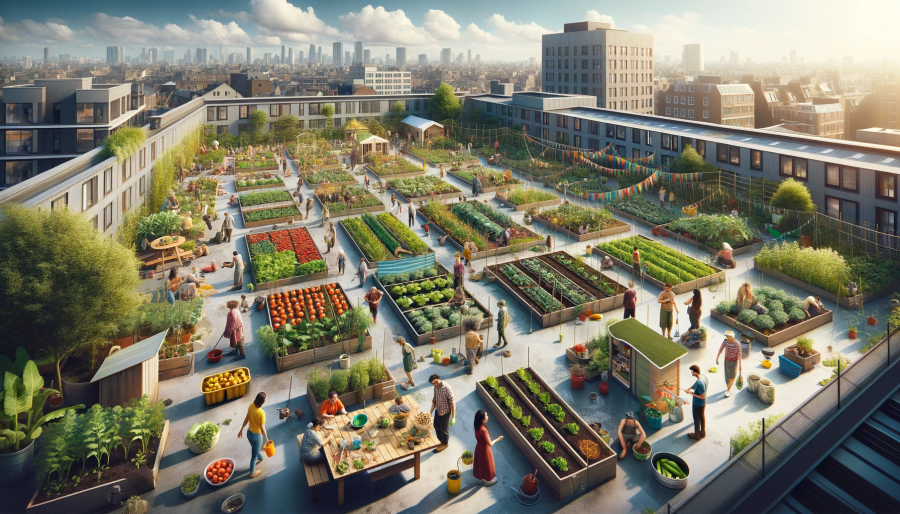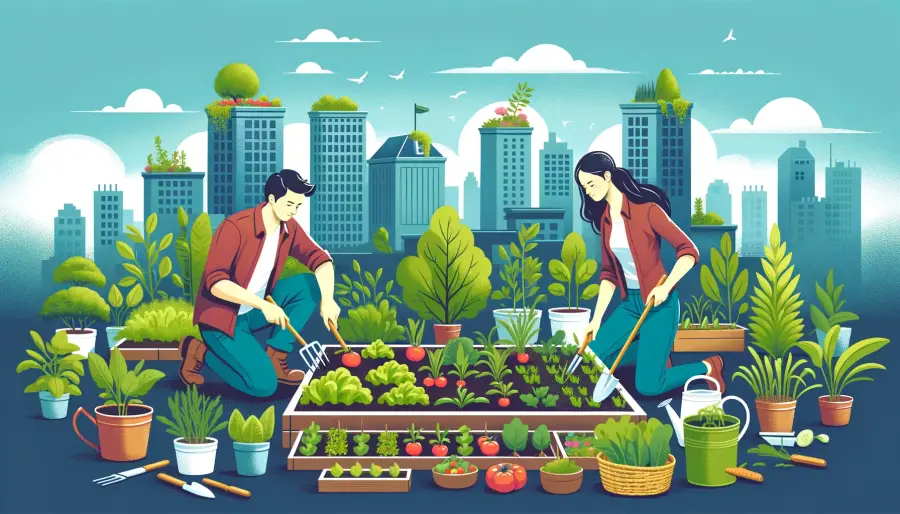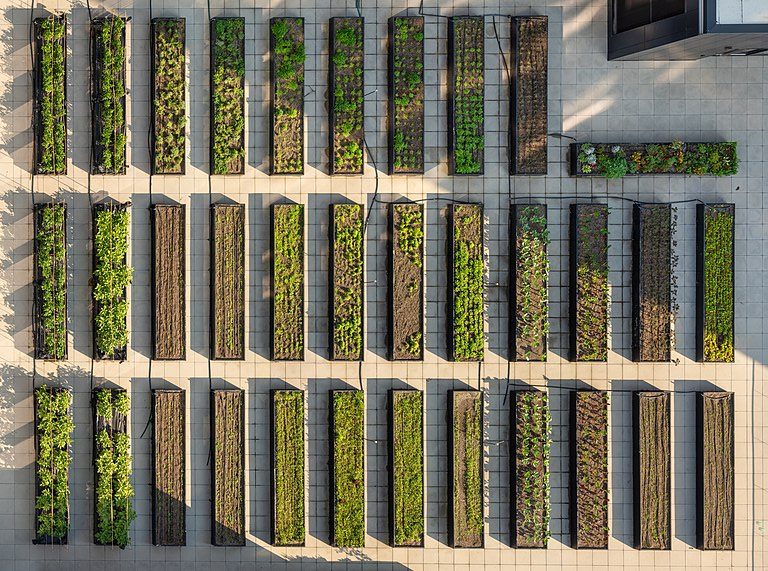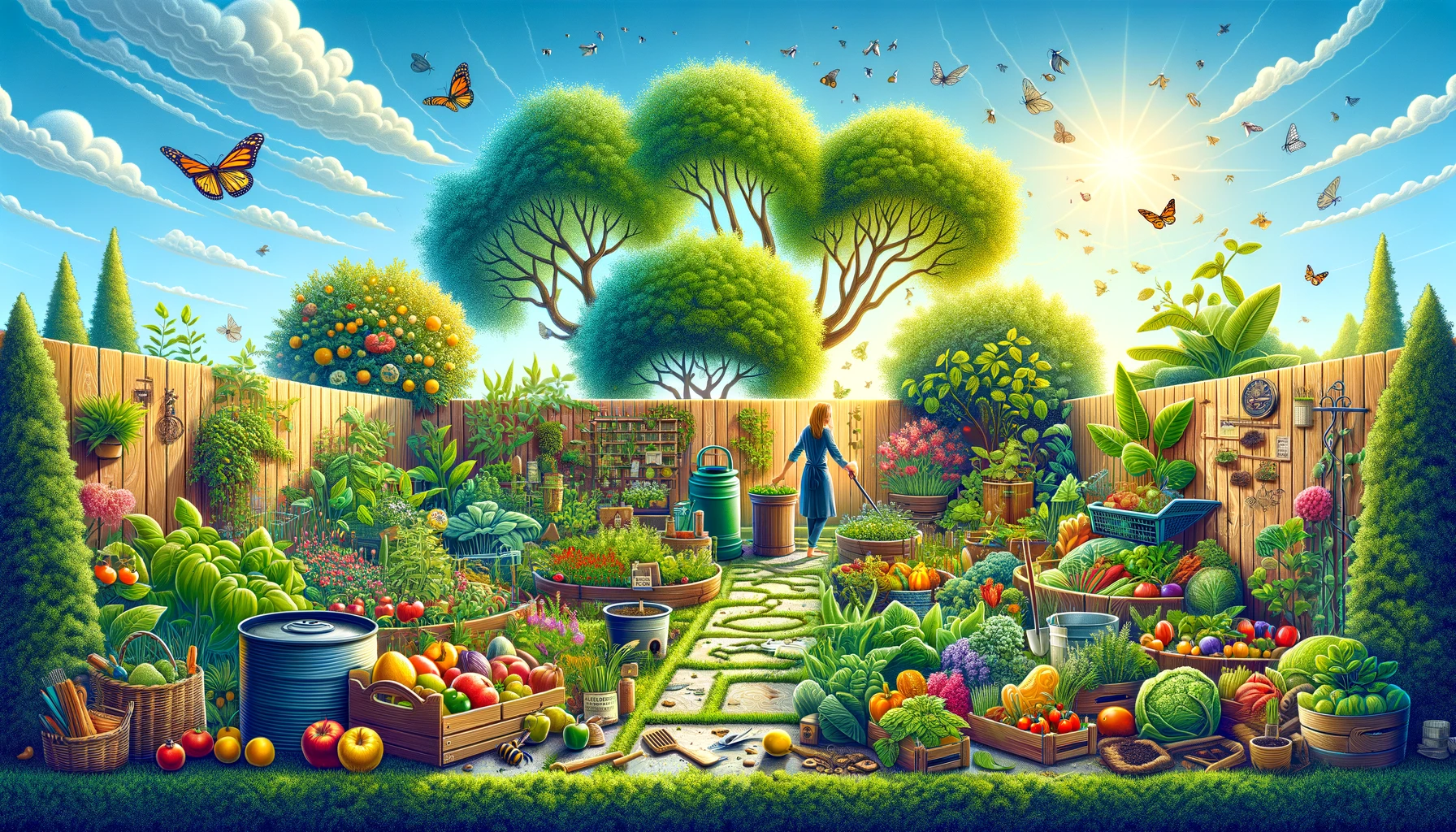We use affiliate links. If you purchase something using one of these links, we may receive compensation or commission.

Discover the joys of rooftop garden vegetables! Dive into our guide for tips on creating your urban oasis, from selecting the best crops to maintenance tricks.
Rooftop Garden Vegetables Key Takeaways:
- Rooftop garden vegetables are a diverse range of edible plants grown on building rooftops.
- Ideal for urban spaces, they include varieties like tomatoes, lettuce, peppers, and herbs, which thrive in well-drained containers and receive ample sunlight.
- They’re perfect for city dwellers seeking fresh, home-grown produce.
Welcome to the world of rooftop garden vegetables! Whether you’re a seasoned green thumb or a budding gardener, our guide is here to help you transform your rooftop into a flourishing haven of fresh, home-grown produce.
Join us as we explore the art of urban gardening and bring a burst of nature to your rooftop!
What is a Rooftop Garden?
A rooftop garden transforms unused roof space into a vibrant green area. It’s more than just placing a few plant pots on a roof; it’s about creating a living, breathing ecosystem high above the city streets.
These gardens bring a touch of nature to urban environments, offering a peaceful retreat and a chance to grow fresh produce right at home.
A roof garden is a garden on the roof of a building. Besides the decorative benefit, roof plantings may provide food, temperature control, hydrological benefits, architectural enhancement, habitats or corridors[1] for wildlife, recreational opportunities, and in large scale it may even have ecological benefits. The practice of cultivating food on the rooftop of buildings is sometimes referred to as rooftop farming.[2] Rooftop farming is usually done using green roof, hydroponics, aeroponics or air-dynaponics systems or container gardens. Wikipedia
Definition and Basic Concept
Rooftop gardens are essentially gardens set up on the roof of a building.
They utilize various containers and raised beds to grow plants, including vegetables, fruits, herbs, and ornamental plants.
This type of gardening is particularly popular in urban areas where ground space is limited.
The idea is to make the most of available space by turning underutilized rooftops into productive and beautiful green spaces.
Roof Garden vs. Green Roof
While both roof gardens and green roofs bring greenery to urban spaces, they have distinct differences:
- Roof Gardens: These are more traditional gardens located on rooftops. They can include a wide variety of plants, from small vegetables and herbs to larger shrubs and even trees.
- Roof gardens often have walkways, seating areas, and other features of a typical garden. They are designed for recreational use, gardening, and aesthetic enhancement.
- Green Roofs: Unlike roof gardens, green roofs are part of a building’s architecture.
- They are typically installed to improve building insulation, manage rainwater, and reduce heat absorption.
- Green roofs usually consist of a layer of vegetation planted over a waterproofing system. They are less about leisure and more about environmental benefits and energy efficiency.
In summary, while both types of gardens enhance urban buildings with greenery, roof gardens are more about creating a functional sustainable organic and abundant urban gardening space, whereas green roofs focus on ecological and building performance benefits.
Rooftop Gardens Benefits

Rooftop gardens are not just a trend; they’re a practical response to urban living challenges.
These gardens use unused roof space wisely, providing a green oasis in concrete jungles.
They are more than just a pleasant aesthetic choice – they offer tangible benefits to city dwellers and the environment like an inspiring community rooftop vegetable garden.
Space Utilization
In cities where ground space is at a premium, rooftop gardens are a smart way to utilize available areas.
They transform otherwise unused rooftops into productive spaces where people can grow vegetables, fruits, and flowers.
This approach maximizes urban space efficiency, turning barren areas into productive, green environments.
Aesthetic Appeal
Rooftop gardens enhance the visual appeal of buildings, adding a touch of nature’s beauty to the urban landscape.
They offer a visually pleasing contrast to the usual concrete and steel.
These gardens can also be designed as recreational spaces, providing residents with a beautiful and serene place to relax and enjoy the outdoors.
Environmental Impact
Rooftop gardens have a positive environmental impact. They can improve air quality by filtering pollutants and producing oxygen.
Additionally, they play a role in temperature regulation, as they can absorb heat and reduce the urban heat island effect.
This means buildings with rooftop gardens may require less energy for cooling, leading to lower carbon emissions.
Contribution to Urban Ecosystems
Rooftop gardens contribute significantly to urban ecosystems. They provide urban edibles for rooftop gardens and habitats for birds, insects, and other wildlife, increasing biodiversity in cities.
These gardens also manage stormwater effectively, reducing runoff and alleviating pressure on urban drainage systems.
By incorporating native plants and sustainable practices, rooftop gardens can become vital components of urban environmental stewardship.
In essence, rooftop gardens are more than just a space for growing plants; they are an integral part of making cities more sustainable, beautiful, and livable.
They represent a harmonious blend of aesthetics, functionality, and environmental responsibility.
Rooftop Vegetable Garden Ideas

Creating a rooftop vegetable garden offers a unique opportunity to experiment with different gardening styles and techniques.
Whether you have a small or large rooftop space, there are plenty of creative ideas to explore.
These gardens not only provide fresh produce but also add a charming green space to urban environments.
Different Layout Options
- Square Foot Gardening: This method is excellent for maximizing space. In square foot gardening, the roof space is divided into small square sections, each growing a different plant.
- It’s a highly efficient way of gardening, making it perfect for rooftops where space is limited.
- Vertical Gardens: Vertical gardening is an innovative solution for space-constrained areas. By growing plants upwards rather than outwards, you can produce more in a smaller footprint.
- This can be achieved through trellises, climbing plants, or vertical planting systems. It’s ideal for crops like beans, peas, and certain types of squash that naturally grow upwards.
Creative Container Options
- Pots: Pots are the most traditional option for rooftop gardens. Lightweight and portable, they come in various sizes and materials. Ensure they have drainage holes to prevent waterlogging.
- Green Walls and Vertical Planters: These are fantastic for growing herbs, lettuce, and small vegetables. Green walls use vertical space efficiently and can be a stunning visual feature.
You can find ready-made vertical planters or even DIY your own. Green walls are not only practical but also add a unique aesthetic to your rooftop garden.
- Hanging Baskets and Window Boxes: These are ideal for growing trailing plants like tomatoes or strawberries. They can be hung from walls or railings, making use of vertical space without the need for floor space.
Rooftop vegetable gardens are not just about growing food; they’re about creativity and making the most of your available space.
By mixing and matching these ideas, you can create a rooftop garden that is both productive and visually appealing.
Whether you’re an experienced gardener or a beginner, there’s a rooftop garden solution that can work for you.
How to Start a Rooftop Garden
Starting a rooftop garden is an exciting venture, but it requires careful planning and consideration of several key factors.
This guide will help you understand the essential steps to create a thriving rooftop garden.
Steps to Begin a Rooftop Garden
- Structural Assessment:
- Safety First: Before starting, it’s crucial to ensure that your rooftop can support the weight of a garden. This might involve consulting with a structural engineer to assess the load-bearing capacity of your roof.
- Weight Considerations: Remember, soil, plants, and containers can be heavy, especially when watered. Factor in the weight of additional elements like furniture or water features if you plan to include them.
- Accessibility:
- Access to the Roof: Consider how you’ll get to your rooftop garden. Is there easy and safe access? You might need to install a ladder, or staircase, or ensure that existing access points are secure.
- Garden Maintenance: Regular access is needed for watering, weeding, and harvesting. Make sure that getting to your garden is not only possible but convenient.
Importance of a Reliable Water Source and Adequate Sunlight
- Water Source:
- Accessibility: A rooftop garden needs regular watering. Having a water source on the roof is ideal. If this isn’t possible, consider how you’ll transport water to your garden.
- Watering System: Options like a drip irrigation system can be very efficient, especially for larger gardens. They help conserve water and ensure consistent moisture for your plants.
- Sunlight:
- Sun Exposure: Most vegetables and fruits need plenty of sunlight to grow. Assess the amount of daily sun your rooftop receives. This will guide you in selecting suitable plant varieties.
- Shade Considerations: If parts of your roof are shaded, plan your garden layout accordingly. Some plants thrive in partial shade, so you can still make use of less sunny spots.
Starting a rooftop garden involves more than just planting seeds. It requires thoughtful planning and preparation.
By considering these crucial aspects, you can ensure that your rooftop garden is not only beautiful and productive but also safe and sustainable.
Rooftop Garden Structural Requirements
Setting up a rooftop garden requires understanding and addressing specific structural requirements to ensure safety and longevity.
This section outlines the key aspects of structural capacity, weight considerations, waterproofing, and drainage for a successful rooftop garden.
Assessing Structural Capacity and Weight Considerations
- Professional Assessment:
- Before starting your garden, it’s vital to have a professional assess the structural integrity of your roof. This assessment determines if the roof can safely support the additional weight of soil, plants, containers, and water.
- Consider factors like the age of the building, existing roof materials, and any previous modifications.
- Weight Management:
- The weight of your garden is a critical factor. This includes not just the weight of plants and soil but also additional elements like furniture, water features, or garden structures.
- Use lightweight materials wherever possible. Opt for lighter soil mixes and consider the use of containers and raised beds to evenly distribute weight.
Importance of Waterproofing and Proper Drainage
- Waterproofing:
- Protecting the roof membrane is crucial to prevent leaks into your building. Installing a waterproof layer or using waterproof containers is essential.
- Regularly check for any signs of water damage or leaks, especially after heavy rains or changes in the garden layout.
- Drainage:
- Proper drainage is key to preventing water accumulation, which can damage both the plants and the roof structure. Ensure there are adequate drainage systems in place.
- Consider the slope of your roof and the placement of drains. Use drainage layers under soil and in containers to facilitate effective water flow.
Addressing these structural requirements is fundamental for the safety and success of your rooftop garden.
By ensuring that your garden is structurally sound, properly waterproofed, and well-drained, you can create a sustainable and enjoyable green space atop your building.
Types of Roof Gardening
Roof gardening can take various forms, each offering unique benefits and requiring different levels of maintenance and resources.
From container gardens to hydroponic systems and raised beds, the type of roof gardening you choose depends on your available space, resources, and gardening goals.
Container Gardening
- Description: This involves growing plants in containers such as pots, planters, or even recycled materials. It’s the most common form of rooftop gardening, especially in urban settings.
- Benefits: Containers are versatile, portable, and can fit in a variety of spaces. They’re ideal for renters or those with limited space.
- Considerations: You’ll need to consider the weight of the containers, especially when filled with soil and watered plants. Also, think about the material of the containers, as some may deteriorate under constant sunlight.
Hydroponic Systems
- Description: Hydroponic gardening involves growing plants in a water-based, nutrient-rich solution without soil. It’s an efficient way to garden in small spaces.
- Benefits: This system uses less water than traditional soil gardening and can result in faster plant growth. It’s great for growing herbs and leafy greens.
- Considerations: Setting up a hydroponic system can be more costly and technically complex. It requires careful monitoring of nutrient levels and pH balance.
Raised Beds
- Description: Raised beds are elevated garden beds filled with soil. They can be constructed from a variety of materials like wood, metal, or stone.
- Benefits: They offer better drainage and can reduce the strain of bending over for garden maintenance. Raised beds can also help define garden spaces on a rooftop.
- Considerations: Consider the weight and materials of the raised beds, ensuring they won’t harm the roof’s surface. The height and depth of the beds are also important for ease of access and root growth of plants.
Selecting the Right Type
- Space Availability: Smaller rooftops might benefit more from container or vertical gardening, while larger spaces can accommodate raised beds or even hydroponic setups.
- Resource Allocation: Consider your budget, time, and gardening experience. Containers and raised beds might be more straightforward for beginners, while hydroponic systems could appeal to those with more experience or interest in technology.
- Gardening Goals: Are you looking to grow a few herbs and flowers, or do you want a more extensive vegetable garden? Your goals will influence the type of garden you set up.
In summary, each type of roof gardening has its own set of advantages and considerations.
Assessing your space, resources, and goals will help you determine the best approach for your rooftop garden.
Rooftop Garden Vegetables and Fruits

Growing vegetables and fruits on a rooftop garden can be incredibly rewarding. It provides fresh produce right at your doorstep. However, selecting the right crops is crucial for success, considering the unique conditions of rooftop environments.
Selection of Suitable Vegetables and Fruits for Rooftop Conditions
- Lightweight and Shallow-Rooted Crops:
- Opt for plants that don’t require deep soil. Examples include lettuce, radishes, and herbs like basil and cilantro.
- Consider the mature size of the plant. Dwarf or bush varieties of larger plants, such as tomatoes or cucumbers, are more suitable.
- Sunlight Exposure:
- Rooftops often receive ample sunlight. Choose plants that thrive in full sun, like tomatoes, peppers, and strawberries.
- If part of your rooftop is shaded, utilize those areas for crops that prefer less intense sun, such as leafy greens or certain herbs.
- Wind Tolerance:
- Rooftops can be windy, which can stress plants. Select wind-resistant varieties and consider using windbreaks like trellises or screens.
- Some crops, like corn, might not be suitable due to their height and susceptibility to wind.
Considerations for Crop Selection
- Water Requirements: Rooftop gardens may dry out faster than ground-level gardens. Choose drought-tolerant varieties and ensure consistent watering practices.
- Container Size: Ensure the container size matches the root growth of the plant. Larger vegetables like eggplants will need bigger pots.
- Pollination: If you plan to grow fruiting crops, ensure there’s access for pollinators, or be prepared to hand-pollinate.
Choosing Heat-Loving Vegetables for Summer
- Heat-Tolerant Varieties: Opt for vegetables that thrive in warmer temperatures. Examples include eggplants, bell peppers, chili peppers, and okra.
- Reflective Heat: Rooftops can get very hot, especially in summer. This can benefit heat-loving crops, but also means you need to monitor water levels closely to prevent drying out.
- Soil Temperature: Use mulch to help regulate soil temperature and retain moisture. Light-colored containers can also help reflect some heat.
Selecting the right fruits and vegetables for your rooftop garden involves understanding the specific challenges and advantages of rooftop conditions.
By carefully choosing your crops, you can enjoy a bountiful harvest from your urban oasis.
Seasonal Vegetables for Rooftop Gardens

Selecting vegetables that are suitable for each season can greatly enhance the productivity and enjoyment of your rooftop garden.
Understanding which vegetables to plant and when will help you maintain a continuous supply of fresh produce throughout the year.
Spring Vegetables
- Cool-Weather Crops: Spring is ideal for planting vegetables that prefer cooler temperatures. Leafy greens like spinach, kale, and lettuce are excellent choices.
- Early Starters: Other vegetables like peas, radishes, and carrots can also be started in spring as they can tolerate cooler weather.
Summer Vegetables
- Heat-Lovers: Summer is the time for vegetables that thrive in warm weather. Tomatoes, peppers, cucumbers, and zucchini are classic choices for the summer months.
- Continuous Harvest: Consider planting vegetables that can be harvested continuously throughout the summer, like green beans and chard.
Fall Vegetables
- Late Season Crops: As the weather cools, it’s time to plant vegetables that can tolerate or even prefer the lower temperatures. Root vegetables like beets and turnips, and greens like collards and mustard greens, are good options.
- Extended Harvest: Some summer crops, like tomatoes, can continue producing into the fall if properly cared for.
Winter Vegetables
- Cold-Hardy Varieties: In areas with mild winters, some vegetables can be grown throughout the season. Look for cold-hardy varieties of kale, Brussels sprouts, and certain types of lettuce.
- Protection: In colder climates, consider using cold frames or greenhouses to extend the growing season.
General Tips for Seasonal Planting
- Succession Planting: To ensure a continuous supply of vegetables, practice succession planting. This means planting new crops as soon as one is harvested.
- Microclimate Consideration: Be aware of the microclimate on your rooftop. It might be warmer or cooler than the surrounding ground level, affecting how plants grow.
- Soil Maintenance: Remember to replenish and maintain the soil between seasons. Adding compost or organic matter can help rejuvenate the soil for the next crop.
By choosing the right vegetables for each season, you can maximize the productivity of your rooftop garden and enjoy a variety of fresh produce throughout the year.
Pest Control and Disease Management in Rooftop Gardens
Managing pests and diseases is a crucial aspect of maintaining a healthy rooftop garden.
Given the unique environment of rooftop spaces, certain considerations and practices can help ensure your garden remains vibrant and productive.
Pest Control in Rooftop Gardens
- Regular Monitoring: Frequently inspect your plants for signs of pests. Early detection is key to preventing infestations.
- Natural Pest Control Methods:
- Companion Planting: Some plants naturally repel certain pests. For instance, marigolds can deter aphids, and basil can keep away mosquitoes and flies.
- Beneficial Insects: Encourage insects like ladybugs and lacewings, which feed on common garden pests.
- Barriers: Physical barriers, such as nets or floating row covers, can protect plants from insects and birds.
- Organic Pesticides: If necessary, use organic pesticides. They are less harmful to the environment and beneficial insects.
Disease Management in Rooftop Gardens
- Good Air Circulation: Ensure that plants are not overcrowded. Proper spacing allows for adequate air circulation, reducing the risk of fungal diseases.
- Watering Practices: Water at the base of the plants to avoid wetting the foliage, as moist leaves can attract diseases. Also, water in the morning so that any water on the leaves can dry during the day.
- Healthy Soil: Maintain soil health with regular additions of compost or organic matter. Healthy soil fosters strong plant growth, making them less susceptible to diseases.
Importance of Regular Monitoring and Maintenance
- Frequent Checks: Regularly checking your garden allows you to spot and address issues before they become serious problems.
- Record Keeping: Keep a garden journal to track the progress of your plants, noting any issues and the measures taken. This can be invaluable for future reference and improving your garden management skills.
By incorporating these pest control and disease management strategies, you can maintain a healthy, thriving rooftop garden. The key is to be proactive and attentive, creating a balanced ecosystem that supports plant health and productivity.
FAQ Section: Navigating the World of Rooftop Gardening
Rooftop gardening brings unique challenges and rewards. This FAQ section addresses common questions and concerns to help both novice and experienced gardeners navigate the world of rooftop gardening.
Q: How often should I water my rooftop garden?
A: Rooftop gardens often require more frequent watering than ground-level gardens due to higher exposure to wind and sun. During hot weather, daily watering might be necessary, especially for containers. It’s essential to check the soil moisture regularly.
Q: What are some effective ways to control pests in a rooftop garden?
A: Natural methods like companion planting, using insect-repelling plants, and encouraging beneficial insects can be effective. Regularly inspect plants for signs of pests and treat them early using organic insecticides if necessary.
Q: How can I protect my rooftop garden from strong winds?
A: Install windbreaks such as trellises, screens, or sturdy plants like shrubs. Also, choose wind-resistant plant varieties and secure loose items like pots and garden tools.
Q: Can I grow a rooftop garden year-round?
A: This depends on your climate. In milder climates, certain cold-hardy vegetables can grow throughout the winter. In colder regions, consider using cold frames or a small greenhouse to extend the growing season.
Q: What kind of maintenance does a rooftop garden require?
A: Regular watering, pruning, and harvesting are key. Additionally, monitor soil health, manage pests and diseases, and make seasonal adjustments to plant care.
Q: How do I know if my roof can support a garden?
A: Consult a structural engineer or a roofing professional to assess your roof’s load-bearing capacity. This is crucial before starting a rooftop garden to ensure safety.
Q: Can I compost on my rooftop garden?
A: Yes, composting can be done on a rooftop garden. Use a compact, sealed compost bin to manage organic waste and create compost for your plants.
Q: What should I do about drainage in my rooftop garden?
A: Ensure proper drainage to prevent water buildup. Use containers with drainage holes, consider a layer of gravel or pebbles at the bottom of containers, and maintain clear pathways for water to drain off the roof.
By addressing these common questions, rooftop gardeners can better manage their gardens, leading to lush, productive green spaces in urban settings.
Conclusion: The Rich Rewards of Rooftop Gardening
Embracing Urban Greening
Rooftop gardening is more than just a hobby; it’s a rewarding journey into the world of urban greening.
These gardens bring a slice of nature to concrete jungles, offering a refreshing escape while contributing positively to the environment.
From growing fresh, organic produce to creating a personal oasis amidst the hustle and bustle of city life, rooftop gardens are a testament to human ingenuity and nature’s resilience.
Multifaceted Benefits
The benefits of rooftop gardening are manifold.
- They provide an excellent way to utilize otherwise wasted space, improve air quality, and reduce urban heat islands.
- These gardens can become a habitat for urban wildlife, promoting biodiversity right in the heart of the city.
- They also offer mental and physical health benefits, providing a serene space for relaxation and a physical activity that nurtures body and soul.
A Call to Action
For those contemplating starting their rooftop garden, the journey can be as fulfilling as the destination.
Each season brings its own joys and challenges, offering endless opportunities for learning and growth.
Whether it’s the satisfaction of harvesting your home-grown vegetables or the tranquility of a green space under the open sky, rooftop gardens enrich lives in countless ways.
I encourage you to embark on this green adventure. Share your experiences, successes, and lessons learned with a community of fellow urban gardeners.
Your rooftop garden story can inspire others and contribute to a greener, more sustainable urban landscape.
Remember, every plant you nurture is a step towards a healthier planet. Happy gardening!





